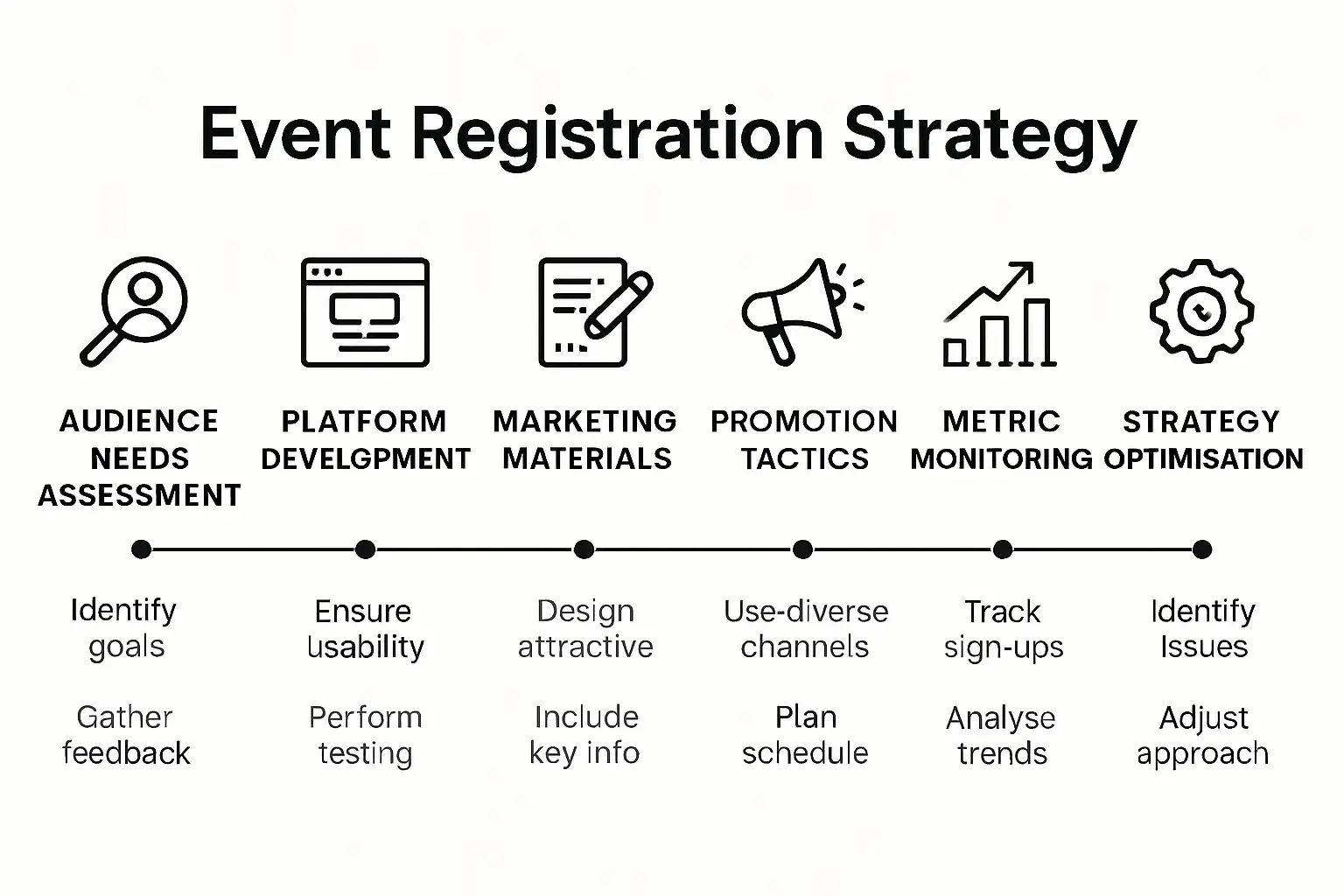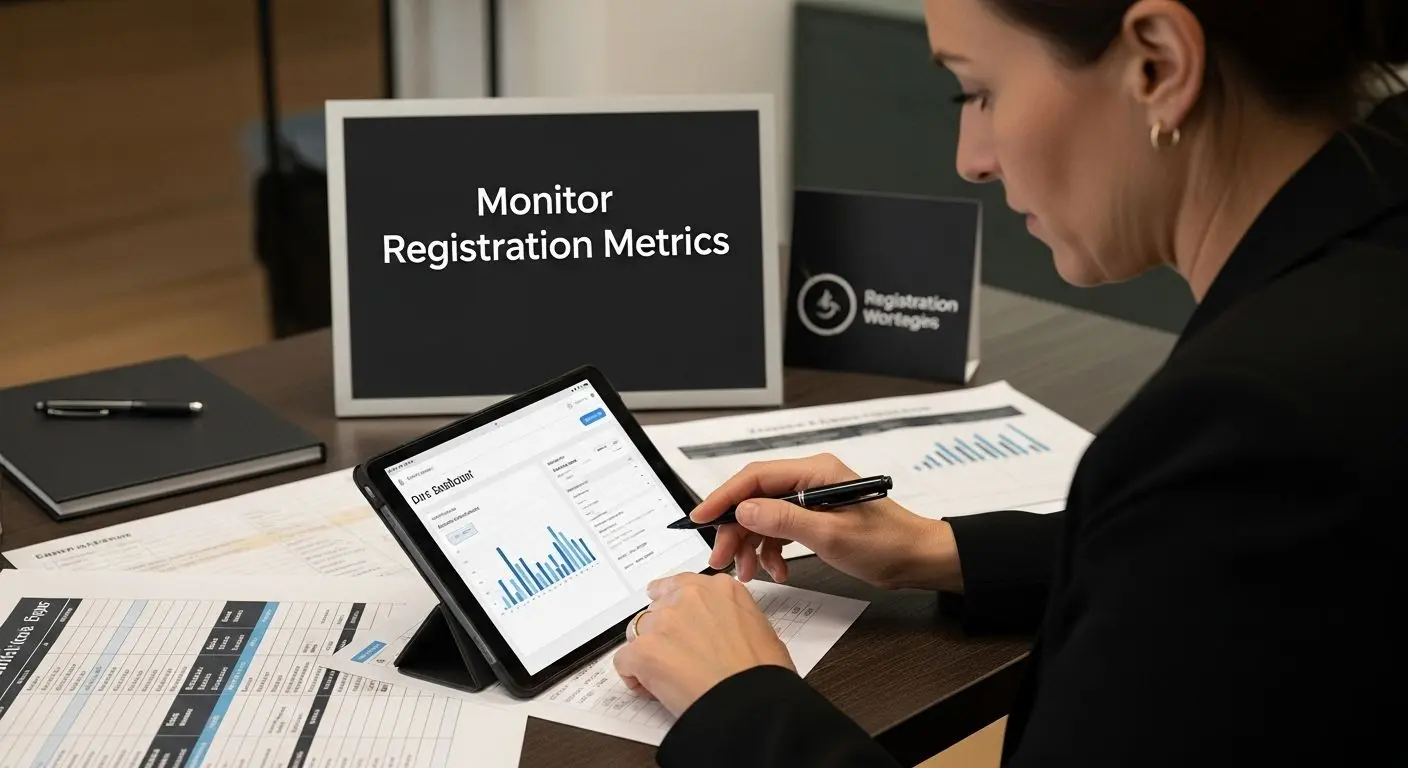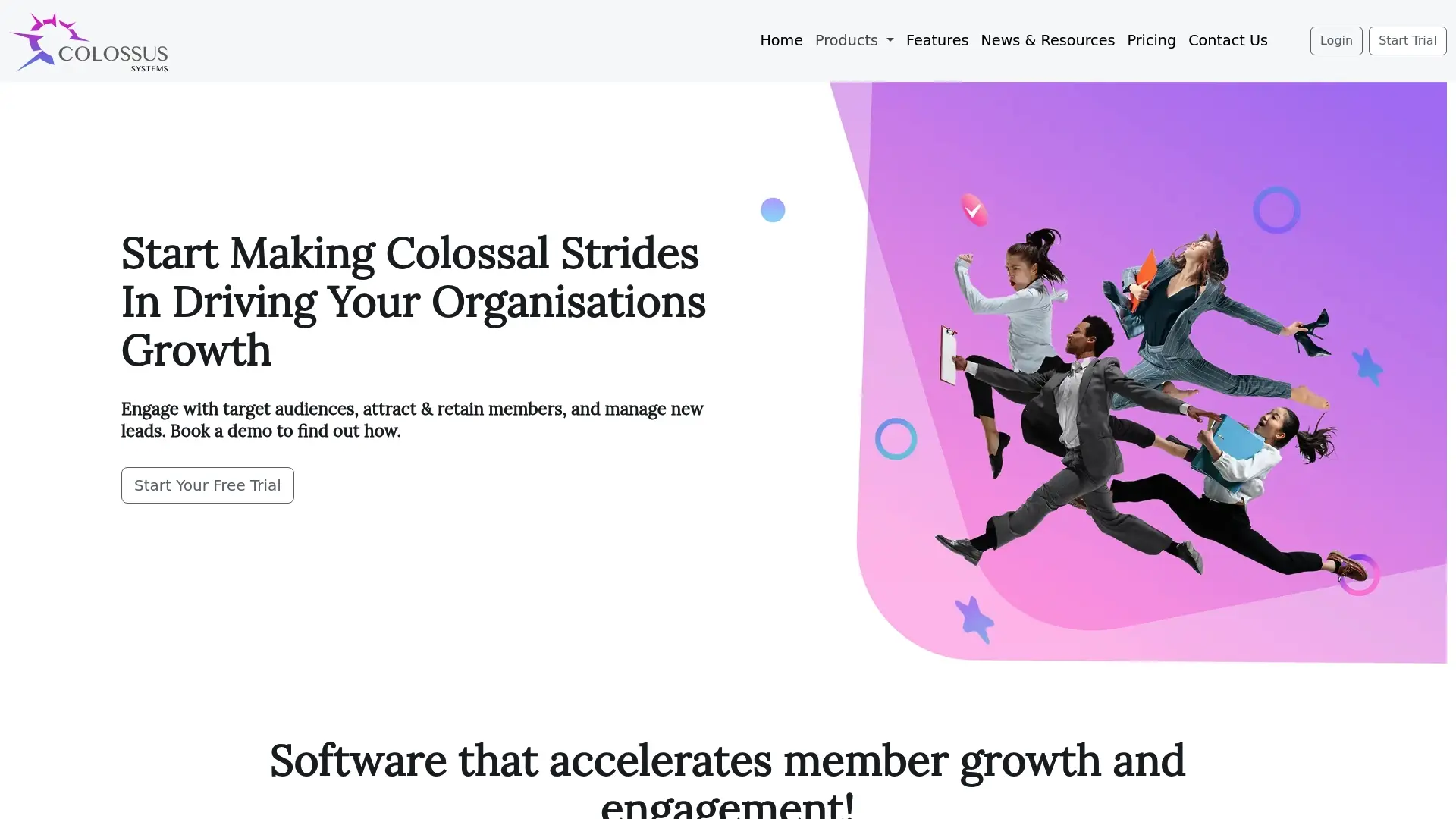Effective Event Registration Strategies for 2025 Success
Getting people to register for your event can feel like an impossible task with so many distractions competing for their attention. Yet, even a single extra field in your registration form can cause up to 30 percent more people to abandon the process. Most believe a sleek platform is all it takes. The real secret lies in truly knowing your audience and making every step feel personal—turning sign-ups from a chore into something people are eager to complete.

Table of Contents
- Step 1: Assess Your Target Audience Needs
- Step 2: Develop A User-Friendly Registration Platform
- Step 3: Create Compelling Marketing Materials
- Step 4: Implement Effective Promotion Tactics
- Step 5: Monitor Registration Metrics And Feedback
- Step 6: Evaluate And Optimize Future Strategies
Below is an overview table summarising each key step for effective event registration success, including primary focus and expected outcomes.
| Step | Main Focus | Expected Outcome |
|---|---|---|
| 1. Assess Audience Needs | Research demographics, segment, create personas | Tailored registration and targeted messaging |
| 2. User-Friendly Platform | Minimise fields, streamline UX, ensure accessibility | Reduced form abandonment, higher completion |
| 3. Marketing Materials | Craft narrative, design visuals, personalise | Inspiring, relevant, and compelling invites |
| 4. Promotion Tactics | Multi-channel promotion, partnerships | Expanded reach, increased registrations |
| 5. Monitor Metrics & Feedback | Analytics, surveys, team reviews | Continuous improvements and reduced drop-off |
| 6. Evaluate & Optimise | Holistic post-event analysis, documentation | Refined future strategies, better engagement |
Quick Summary
| Key Point | Explanation |
|---|---|
| 1. Understand your audience’s needs | Conduct detailed research to gather demographic and psychographic data to tailor registration experiences effectively. |
| 2. Create a user-friendly platform | Design a straightforward registration process with minimal steps to enhance user experience and reduce abandonment rates. |
| 3. Develop compelling marketing materials | Craft narratives that resonate with your audience, highlighting the event’s unique benefits to inspire registration. |
| 4. Implement multi-channel promotion tactics | Use diverse digital marketing strategies, including social media and email, to reach potential attendees effectively. |
| 5. Continuously monitor and optimise metrics | Track registration data and gather feedback to refine future strategies for improved attendee engagement and experience. |

Step 1: Assess Your Target Audience Needs
Understanding your target audience is the foundational cornerstone of successful event registration strategies. This critical first step determines how effectively you can attract, engage, and convert potential attendees into registered participants. By developing a comprehensive understanding of who your audience is and what they genuinely want, you can design a registration process that feels personalised and compelling.
Begin by gathering demographic and psychographic data about your potential attendees. This means looking beyond basic age and location information to understand deeper motivations, professional challenges, learning preferences, and event expectations. Professional membership databases, previous event feedback, and targeted surveys can provide rich insights into attendee profiles.
Next, conduct a detailed segmentation analysis to break down your potential audience into distinct groups. Each segment might have unique characteristics requiring tailored communication and registration approaches. For instance, early career professionals might respond differently to event marketing compared to seasoned industry veterans. Consider creating detailed audience personas that represent typical attendee archetypes, capturing their goals, pain points, and preferred interaction styles.
Discover advanced audience segmentation techniques can help you refine your understanding and create more targeted registration experiences. Pay special attention to how different audience segments prefer to engage with registration processes. Some might appreciate a quick, streamlined digital registration, while others might want more personalised interaction or phone-based support.
Successful audience assessment involves continuous learning. Implement feedback mechanisms during and after registration to understand what attracted attendees and what might have created friction. Track metrics like registration completion rates, time spent on registration pages, and dropout points to continually optimise your approach. The goal is to create a registration experience that feels so intuitive and appealing that potential attendees are eager to complete the process.
By the end of this step, you should have a clear, nuanced understanding of your target audience that informs every subsequent aspect of your event registration strategy. Your audience insights will become the blueprint for designing registration flows, crafting compelling marketing messages, and ultimately delivering an event experience that resonates deeply with participants.
Step 2: Develop a User-Friendly Registration Platform
Creating a user-friendly registration platform is more than just designing a functional webpage; it is about crafting an intuitive, welcoming digital experience that seamlessly guides potential attendees from initial interest to confirmed participation. The platform you develop must transform the registration process from a potential barrier into an engaging, straightforward journey that reflects the quality of your event.
Start by prioritising simplicity and clarity in your platform design. Minimise the number of form fields and steps required to complete registration, ensuring that only absolutely essential information is collected. Complex, lengthy registration processes discourage participation and increase abandonment rates. Use progressive disclosure techniques, where additional details can be collected after initial signup, making the first interaction as frictionless as possible.
Consider the user experience across multiple devices and platforms. Your registration system must be fully responsive, providing an equally smooth experience whether accessed from a desktop computer, tablet, or smartphone. This means implementing clean, adaptable design principles that automatically adjust layout and functionality based on screen size. Learn more about creating adaptive registration experiences to ensure accessibility for all potential attendees.
The table below organises essential registration platform features, providing a clear reference for design priorities and their purposes.
| Feature | Purpose | Benefit |
|---|---|---|
| Minimal Form Fields | Make registration quick and simple | Lowers abandonment rate |
| Real-Time Validation | Instantly check and correct errors | Reduces user frustration |
| Autofill Capabilities | Speed up information entry | Improves registration speed |
| Responsive Design | Works across desktops, tablets, mobiles | Increases accessibility |
| Social/Single Sign-On | Allow registration via existing accounts | Eases signup process |
| Secure Payment Processing | Safeguard attendee financial information | Builds trust and confidence |
| Custom Branding | Reflect event and organisational identity | Enhances professional image |
Implement intelligent form design features that reduce user frustration. Integrate real-time validation to provide immediate feedback on input errors, offer autofill capabilities where possible, and create clear, descriptive error messages that guide users towards correct information submission. Consider incorporating social media or single sign-on options to streamline the registration process, allowing users to complete signup using existing accounts.
Technology selection is crucial. Choose a registration platform that offers robust backend capabilities including secure payment processing, automatic confirmation emails, and easy data management. The platform should provide customisation options that allow you to brand the registration experience, making it feel like a natural extension of your event’s identity.
By the conclusion of this step, your registration platform should be a sleek, user-centric tool that not only captures necessary information but also builds excitement about the upcoming event. The most successful platforms transform registration from a transactional experience into the first meaningful interaction attendees have with your event, setting positive expectations for what is to come.
Step 3: Create Compelling Marketing Materials
Marketing materials are the critical bridge between your event concept and potential attendees, transforming initial interest into committed participation. The materials you develop must not merely inform but inspire, creating an emotional connection that motivates your target audience to register and engage.
Craft a compelling narrative that goes beyond basic event details. Your marketing materials should tell a story that resonates with your audience’s professional aspirations and personal growth objectives. Use language that speaks directly to their challenges, opportunities, and desired outcomes. Highlight the unique value proposition of your event, explaining precisely how attendance will benefit participants in tangible, meaningful ways.
Explore strategic event marketing techniques that can elevate your promotional approach. Visual design plays a crucial role in capturing attention. Invest in high-quality, professional graphics that reflect the event’s tone and target audience. Utilise a consistent colour palette, typography, and imagery that align with your organisational brand while creating a sense of excitement and professionalism. Incorporate visuals that represent the diversity of your potential attendees, ensuring they can see themselves reflected in the event materials.
Develop a multi-channel marketing strategy that ensures your materials reach potential attendees through diverse touchpoints. This means creating adaptable content that can be seamlessly shared across email, social media platforms, professional networking sites, and organisational websites. Each piece of marketing material should include clear, prominent calls-to-action that guide potential attendees towards the registration process. Include essential information such as event date, location, key speakers or session highlights, and the specific benefits attendees will gain.
Personalisation can significantly enhance the effectiveness of your marketing materials. Segment your communication approaches based on the audience personas you developed earlier. Different professional groups might respond to different messaging styles and visual approaches. Consider creating targeted versions of your marketing materials that speak directly to specific audience segments, addressing their unique professional contexts and learning objectives.
By the conclusion of this step, your marketing materials should be a powerful, cohesive suite of communications that not only inform but genuinely excite potential attendees. They should serve as a compelling invitation that transforms event awareness into active registration enthusiasm, setting the stage for a successful and well-attended event.
Step 4: Implement Effective Promotion Tactics
Successful event promotion requires a strategic, multi-channel approach that reaches potential attendees through diverse communication pathways. Your promotion tactics must be dynamic, targeted, and designed to generate genuine excitement and engagement around your event.
Digital marketing channels become your primary communication infrastructure, with social media platforms serving as critical engagement tools. Develop a comprehensive social media strategy that includes regular, compelling content previewing event highlights, speaker insights, and unique networking opportunities. Create platform-specific content that maintains a consistent narrative while adapting to each platform’s unique communication style. Instagram might feature visually appealing graphics, LinkedIn could showcase professional development aspects, and Twitter could provide quick, punchy event teasers.
Discover advanced event marketing strategies that can amplify your promotional reach. Email marketing remains a powerful tool when executed thoughtfully. Segment your email lists based on professional interests, previous event participation, and audience personas. Craft personalised email sequences that build anticipation, offering early bird registration incentives, exclusive content previews, and progressive information reveals that maintain audience curiosity.
Leverage professional networks and partnerships to extend your event’s promotional reach. Collaborate with industry associations, professional groups, and relevant influencers who can authentically promote your event to their established networks. These partnerships provide credibility and access to targeted audience segments that might be challenging to reach through traditional marketing channels.
Utilise retargeting and paid advertising strategies to maintain visibility among potential attendees. Develop carefully crafted digital advertising campaigns that appear on platforms frequented by your target audience. Use precise targeting options to ensure your promotional materials reach professionals most likely to be interested in your event. Monitor advertising performance meticulously, adjusting strategies based on engagement metrics and conversion rates.
By the conclusion of this step, your promotion tactics should create a comprehensive, multi-dimensional marketing ecosystem that generates genuine excitement and drives potential attendees towards registration. The most effective promotional strategies transform event awareness into an unmissable professional opportunity.
Step 5: Monitor Registration Metrics and Feedback
Monitoring registration metrics and feedback transforms raw data into actionable insights that can dramatically improve future event strategies. This critical step moves beyond passive observation, actively using data to understand attendee behaviours, preferences, and potential areas of improvement in your registration process.
Develop a comprehensive metrics tracking system that captures both quantitative and qualitative data points throughout the registration journey. This means implementing real-time analytics that track conversion rates, registration completion times, dropout points, and demographic engagement patterns. Pay close attention to metrics that reveal potential friction in the registration process, such as the number of users who start but do not complete registration, time spent on different registration pages, and device-specific registration behaviours.
Learn advanced techniques for member satisfaction tracking to enhance your data collection approach. Implement post-registration surveys that capture detailed feedback about the registration experience. Design these surveys to be concise yet comprehensive, asking specific questions about user interface ease, information clarity, and overall registration satisfaction. Utilize a mix of multiple-choice and open-ended questions that allow attendees to provide nuanced insights into their experience.
Create a systematic approach to feedback analysis that goes beyond surface-level observations. Regularly review registration data and survey responses, looking for recurring themes, pain points, and potential improvements. Establish a cross-functional team meeting schedule where marketing, event management, and technical teams can collaboratively review these insights and develop actionable strategies for enhancement.
Utilise advanced data visualization tools to transform complex registration metrics into easily digestible insights. Create dashboards that provide real-time visibility into registration performance, allowing your team to make rapid, data-driven decisions. These visualizations should highlight key performance indicators, trend lines, and comparative analyses that reveal the effectiveness of your registration strategies.
By the conclusion of this step, you should have a robust, dynamic system for continuously monitoring and improving your event registration process. The most successful organisations view metrics and feedback not as static reports, but as living, breathing insights that drive continuous improvement and innovation in their event registration strategies.

Step 6: Evaluate and Optimize Future Strategies
Evaluating and optimizing future event registration strategies transforms past experiences into powerful blueprints for continuous improvement. This critical final step is about creating a systematic approach to learning, adapting, and refining your registration processes based on comprehensive insights gathered throughout your previous events.
Conduct a holistic post-event analysis that goes beyond surface-level metrics. Develop a structured review framework that examines every aspect of the registration journey, from initial marketing efforts to post-event feedback. Compare actual outcomes against your original objectives, identifying both successful strategies and areas requiring significant improvement. This comprehensive review should integrate quantitative data from registration metrics with qualitative insights from attendee surveys and stakeholder interviews.
Explore advanced member satisfaction improvement techniques to enhance your evaluation process. Create a dynamic improvement roadmap that prioritizes actionable insights. This means translating your analysis into specific, measurable strategies for future events. Develop a weighted scoring system that helps your team objectively assess which modifications will have the most significant impact on future registration performance.
Establish a culture of continuous learning within your organisation. Schedule dedicated strategy sessions where team members from different departments can collaboratively review evaluation findings. Encourage open dialogue about challenges encountered, innovative solutions proposed, and potential experimental approaches for future events. These sessions should result in concrete action plans with clear ownership, timelines, and success metrics.
Implement a robust documentation system that captures institutional knowledge from each event registration cycle. Create comprehensive reports that not only highlight metrics and insights but also provide contextual understanding of why certain strategies worked or failed. This institutional memory becomes a valuable resource for training new team members and maintaining consistency in your event registration approach.
By the conclusion of this step, your event registration strategy should be a living, adaptive system that continuously evolves. The most successful organisations view each event not as an isolated incident, but as a learning opportunity that incrementally enhances their ability to attract, engage, and deliver exceptional experiences for their audience.
Accelerate Your Event Registration Success with Colossus Systems
Are you struggling to convert your audience insights and compelling marketing into seamless event registration? If your organisation has ever faced high registration abandonment, complex onboarding processes or difficulty tracking attendee data, you are not alone. The article “Effective Event Registration Strategies for 2025 Success” highlights the importance of user-friendly registration platforms, targeted communication and actionable analytics. Without the right digital tools, even the best strategies can feel overwhelming and fragmented. Imagine if you could harness a unified solution to remove these barriers and finally see your registration numbers soar.

Discover how Colossus Systems can help you put these proven strategies into action. Our fully customisable event management and registration platform helps you engage your audience at every touchpoint. Empower your team to streamline registration workflows, personalise marketing communication and monitor real-time analytics with ease. Visit Colossus Systems today to transform your event registration process. Take your next event to new heights before your competition does. If you are ready to boost conversions and deliver a superior attendee experience, explore our modern membership engagement solutions now.
Frequently Asked Questions
What are the key elements of effective event registration strategies?
Effective event registration strategies should focus on assessing audience needs, developing a user-friendly registration platform, creating compelling marketing materials, implementing effective promotion tactics, monitoring registration metrics, and evaluating future strategies for continuous improvement.
How can I assess my target audience’s needs for event registration?
You can assess your target audience’s needs by gathering demographic and psychographic data, segmenting your audience into distinct groups, and creating detailed audience personas that represent typical attendee archetypes, capturing their goals, pain points, and preferred interaction styles.
What should be included in user-friendly registration platform design?
A user-friendly registration platform should prioritise simplicity, minimise form fields, be responsive across devices, utilise intelligent form features like real-time validation and autofill, and ensure secure payment processing with customisation options to reflect your event’s identity.
How can I effectively monitor registration metrics and feedback?
Effective monitoring of registration metrics involves implementing a comprehensive metrics tracking system to capture quantitative and qualitative data throughout the registration journey and conducting post-registration surveys to gather attendee feedback on their experience.
Recommended
- Event Marketing Strategies for Membership Groups and Associations|CS
- Event Marketing Ideas for Membership Groups | Colossus Systems
- How to Host Virtual Conferences: A Step-by-Step Guide|CS
- Event Risk Management Strategies for Membership Organisations|CS
- The Future Importance of Event Marketing Within Companies - team.i
- Marketing Conferences 2025 – The Ultimate Global Guide - Solution for Guru